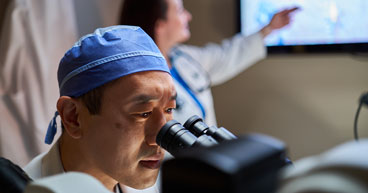
Sometimes a rash is more than irritated skin. It may be an allergic reaction to something you’ve touched or eaten. It may be a skin disease—possibly eczema or psoriasis. Far less common, but something to consider after other causes have been ruled out, is cancer.
Some types of non-Hodgkin lymphoma affect the skin. A rash may be the first and most significant symptom. Skin lymphomas are considered blood cancers and not skin cancers because they start in lymphocytes that are present in the skin, not in the skin itself.
“Skin is not the first place that we think of as being a target for lymphoma cells, but it certainly can happen,” says Leslie Popplewell, MD, Medical Director of Hematology and Blood and Marrow Transplant at City of Hope® Atlanta. “The skin is the biggest organ in the body and if the skin is the lymphoma focus, those patients can get into trouble and really need a team of specialists.”
Lymphoma begins when the lymphocytes—disease-fighting white blood cells that are part of the immune system—become abnormal and grow out of control. Lymphocytes are found throughout the body’s lymphatic system, including in lymph nodes, bone marrow, the spleen and the thymus. They are also contained in other organs such as the skin, so lymphoma’s cancerous cells may appear virtually anywhere.
In this article we will examine:
- When lymphoma causes a rash
- Skin lymphoma types
- What does a lymphoma rash look like?
- What does a lymphoma rash feel like?
- How is a lymphoma rash diagnosed?
- Lymphoma rash treatment
- Lymphoma care at City of Hope
If you’ve been diagnosed with a blood cancer, such as leukemia, lymphoma or multiple myeloma, and have questions about your treatment plan, or if you’re interested in a second opinion on your diagnosis, call us or chat online with a member of our team.
When lymphoma causes a rash
Rashes are generally connected to a specific variety of lymphoma, known as skin lymphomas or cutaneous lymphomas. In these variants, cancerous lymphocytes begin irritating the skin, causing redness and dryness in the affected areas.
In mycosis fungoides, the most common type of skin lymphoma, the appearance of a rash often occurs gradually over time. It may start off as small patches of dry, red skin on a small area of the body, and be similar to eczema, dermatitis or psoriasis. As it advances, the rash may thicken in places, forming plaques that may fester and turn into sores. Later, small bumps or tumors may start to appear on or under the skin.
At other times, a rash may appear that is not caused by lymphoma, but by treatments for the disease.
“People who have lymphoma are often getting lots of medications that can cause a rash, so it's nice to have a dermatologist available who can come in and evaluate,” Dr. Popplewell says.
Lymphoma treatments that may produce a rash include:
- Chemotherapy
- Radiation therapy
- Allogeneic stem cell transplants
- Immunotherapy
- Targeted therapy
A rash is not a common symptom of Hodgkin lymphoma, but about one-third of patients with that disease experience severe itchiness. The condition, called pruritus, may be linked to the body’s release of cytokines from the immune system to fight the cancer.
“Classical Hodgkin lymphoma is known for occasionally resulting in severe itching, so itching without explanation is a reason to start looking for classical Hodgkin lymphoma—and sometimes it can be pretty severe,” Dr. Popplewell says. “It tends to improve after the patient starts treatment.”
Skin lymphoma types
A variety of non-Hodgkin lymphomas are classified as skin lymphomas.
“There are some lymphomas that present primarily in the skin in the category called cutaneous T-cell lymphoma (CTCL). There are also a couple of cutaneous B-cell lymphomas,” Dr. Popplewell says.
Mycosis fungoides, which falls into the CTCL category, is a slow-developing non-Hodgkin lymphoma that begins with red, scaly patches—typically found on the lower trunk, thighs, buttocks or breasts. The patches may be itchy and may last for months or years. They may be limited to a small section of the body or spread to other areas. The patches may thicken, forming raised reddish-brown plaques. Progression may also include swellings in the skin, such as nodules or tumors.
Some variants of mycosis fungoides include:
- Granulomatous Slack Skin
- Pagetoid Reticulosis (Woringer-Kolopp Disease)
- Folliculotropic mycosis fungoides
Other forms of CTCL include:
Sezary syndrome, which is more aggressive than mycosis fungoides and harder to treat, with cancer cells in the blood as well as the lymph system. People diagnosed with the syndrome often have a red, itchy rash over most or all of their body. This condition, known as erythroderma, may resemble severe sunburn.
Lymphomatoid Papulosis, a non-aggressive lymphoma that features self-healing pink or red brown bumps or papules, which may appear anywhere on the body and that come and go, sometimes leaving scarring.
Primary Cutaneous Anaplastic Large Cell Lymphoma, which affects the skin primarily and may appear as single or multiple raised red skin lesions, nodules or tumors.
Subcutaneous Panniculitic T-Cell Lymphoma, which mimics the inflammation of fat under the outer layer of skin and may produce large bumps under the skin.
Of the primary cutaneous lymphomas, about 65 percent are of the T-cell lymphocyte type, 25 percent are of the B-cell lymphocyte type and 10 percent are unspecific, according to a 2012 study.
The most common cutaneous B-cell lymphoma is primary cutaneous follicle center lymphoma, usually involving hair cells on the head, neck, chest or back. The rash may be composed of pink, reddish or purple plaques or nodules.
Other forms of cutaneous B-cell lymphoma include:
- Primary cutaneous marginal B-cell lymphoma
- Primary cutaneous diffuse large B-cell lymphoma
What does a lymphoma rash look like?
As the descriptions of the various skin lymphomas show, patients may experience rashes having a wide range of appearances. Lymphoma rashes are not limited to any specific locations on the body, though they often show up on portions of the body not exposed to sunlight. The American Cancer Society says rashes may appear as one or more of the following:
- Patches (flat lesions)
- Plaques (thick, raised lesions)
- Papules (pimple-like lesions)
- Nodules or tumors (larger bumps or bumps under the skin)
The color of lymphoma rashes ranges from pinkish to reddish/reddish brown to purplish.
What does a lymphoma rash feel like?
Patches and plaques associated with skin lymphoma often are dry and scaly to the touch, though some may be smooth. They may cause itching sensations all over the body. Full-body rashes often associated with Sezary syndrome may feel hot, sore and itchy.
When a skin lymphoma reaches the lymph glands, it may inflame the glands and produce a lump that may be felt, possibly in the neck, underarm or groin.
Other symptoms a person may experience from skin lymphoma include:
- Unexplained weight loss
- Fever
- Profuse sweating
- Severe itchiness
How is a lymphoma rash diagnosed?
If you have a rash, doctors will check to see if it may be explained by something more common than cancer, such as an allergy or skin condition.
“If you have a skin rash that is persistent and does not respond to treatment, then it deserves a biopsy. If it’s skin lymphoma, cutaneous lymphoma, then you’re going to find those lymphoma cells in the skin,” Dr. Popplewell says. “On the biopsy, the pathologist can apply special stains and use techniques like flow cytometry or even gene rearrangement testing to pin down a diagnosis of a cutaneous lymphoma. There’s a lot they can do diagnostically to pin that down.”
A single biopsy may not do the trick. Lymphoma Action, a charity in the United Kingdom that provides information, support and connections to people with lymphoma, says it takes three years on average to diagnose skin lymphoma and rule out other, more common conditions.
Among the procedures patients may undergo before reaching a conclusive diagnosis:
- Physical exams
- Skin biopsies
- Lymph node biopsies
- Blood tests
- Chromosome tests
- Imaging tests, such as X-rays and computed tomography (CT) scans
A diagnosis “really requires a cohesive program where all the different subspecialties are available,” Dr. Popplewell says. A multidisciplinary team may include a pathologist, dermatologist, hematologist or clinical oncologist specializing in lymphoma, radiation oncologist, social worker and others, she says.
Lymphoma rash treatment
“Cutaneous T-cell lymphoma often can be treated with topical therapies, such as medicated creams or ointment and oral medications are sometimes used as well,” Dr. Popplewell says. “Sometimes we give radiation to very localized skin lymphomas. If the lymphoma turns out to be more systemic, then IV therapy may be indicated.”
Types of therapy directed at the skin include:
- Topical corticosteroids
- Topical chemotherapy
- Topical immunotherapy
- Retinoids (vitamin A derivatives)
- Phototherapy
- Radiation therapy
- Surgery
- Interferon
- Retinoids
- Histone Deacetylase (HDAC) Inhibitors
- Extracorporeal Photopheresis
- Antibodies
- Chemotherapy
- Stem Cell Transplant
Lymphoma care at City of Hope
At City of Hope, we treat lymphoma with standard-of-care and evidence-based treatments and technology, while also helping patients maintain their quality of life with an integrative, whole-person approach to care.
Because your care team works all under one roof, you have access to a team of physicians, practitioners and support staff who can tailor treatments and supportive therapies to your specific needs, in real time, collaborating on any adjustments needed to your care plan.
If you’ve been diagnosed with a blood cancer, such as leukemia, lymphoma or multiple myeloma, and have questions about your treatment plan, or if you’re interested in a second opinion on your diagnosis, call us or chat online with a member of our team.


